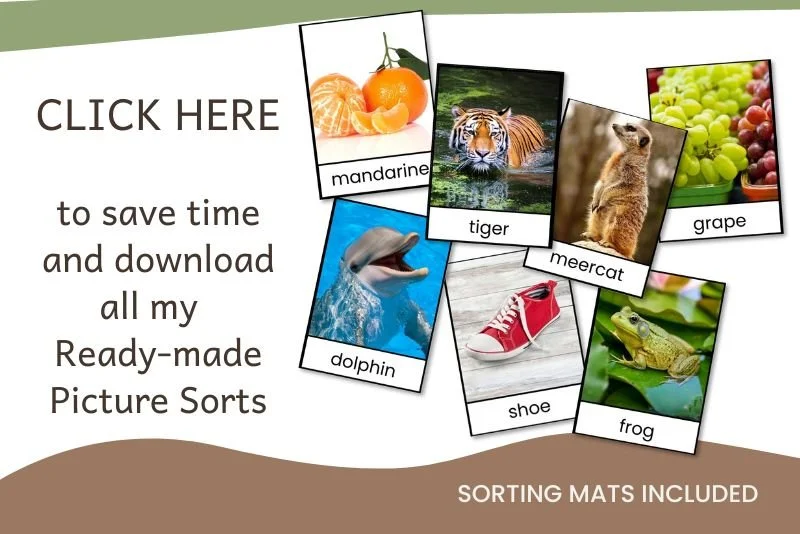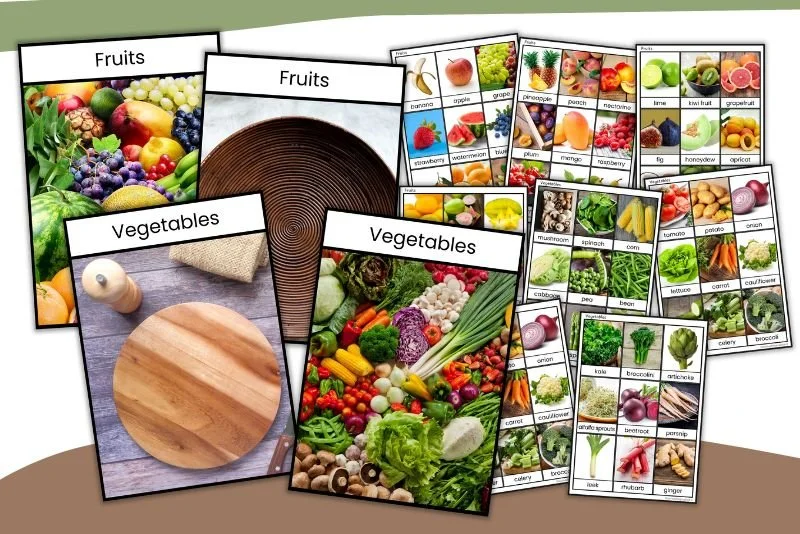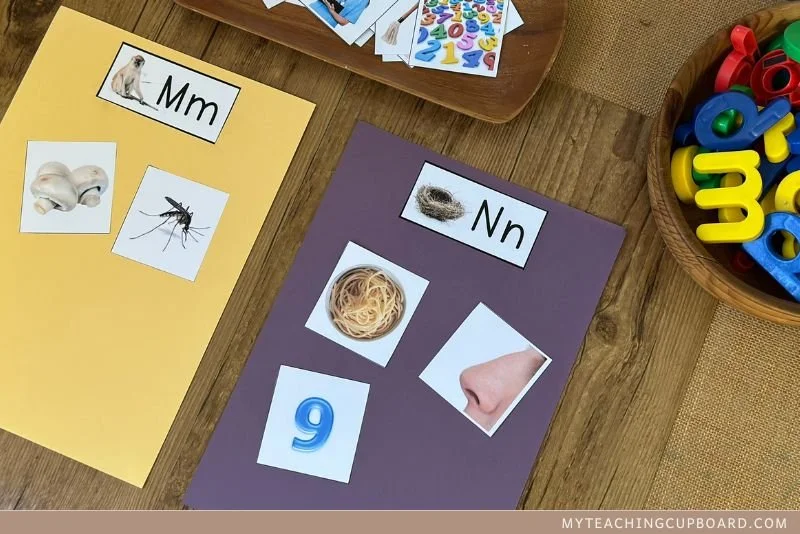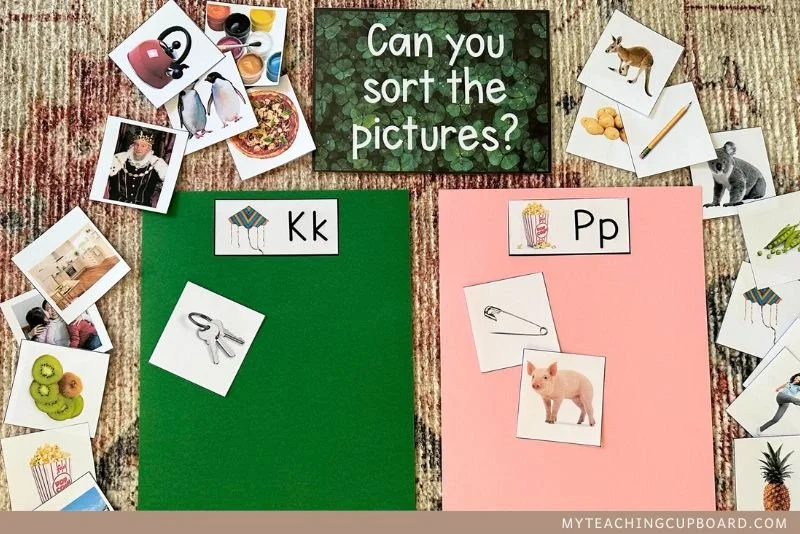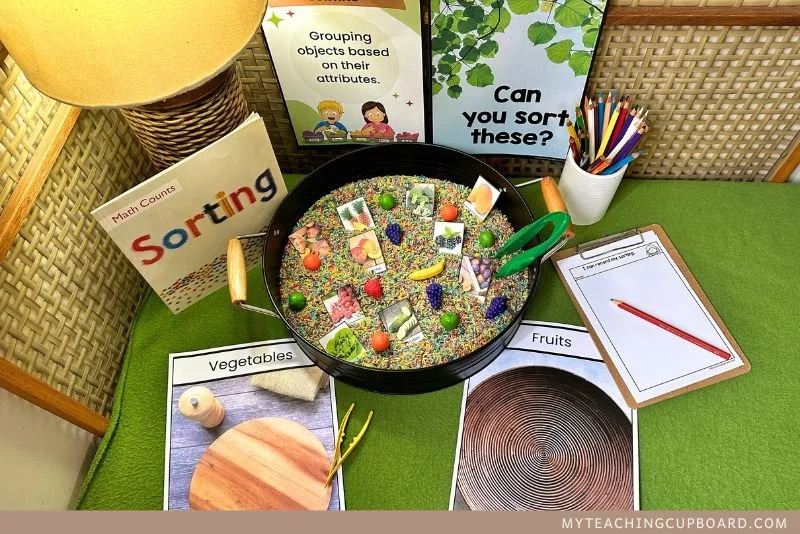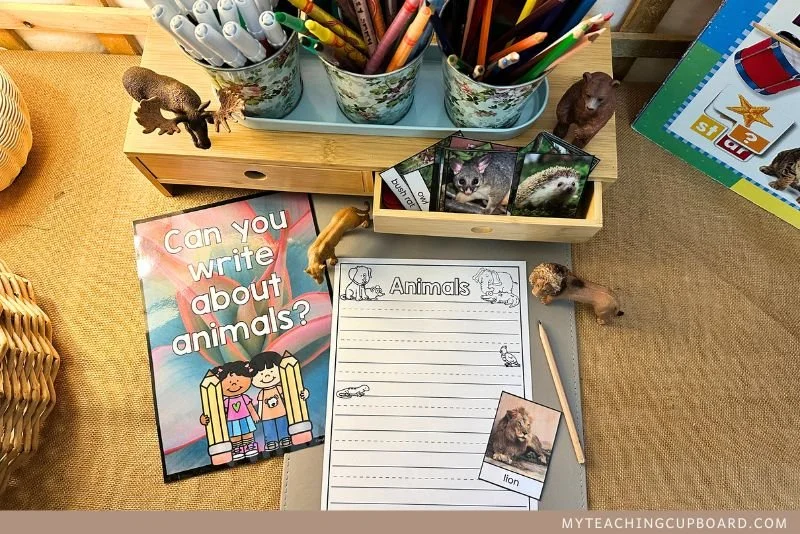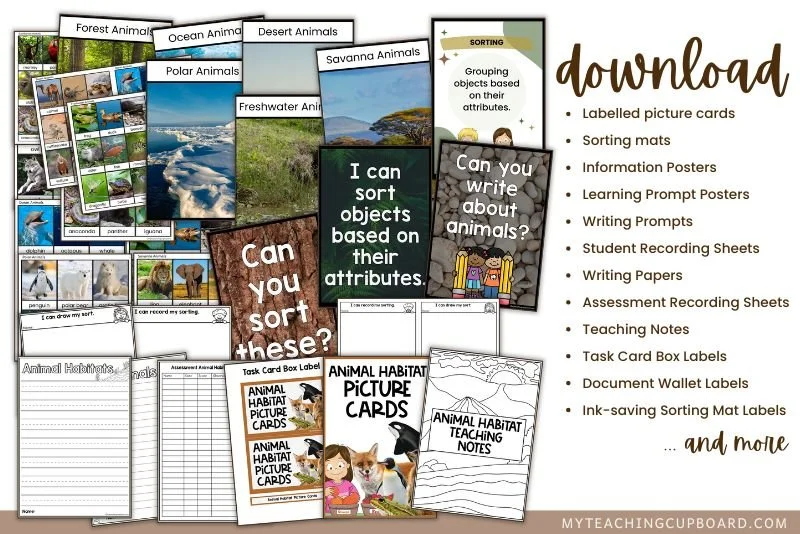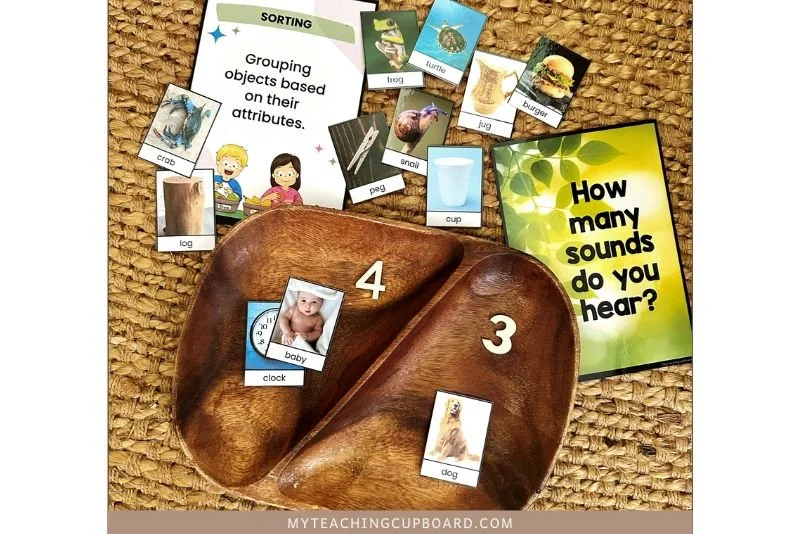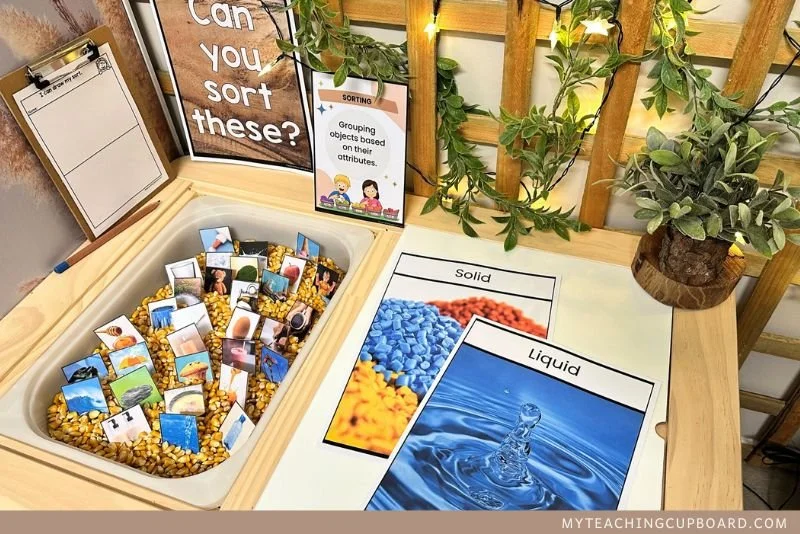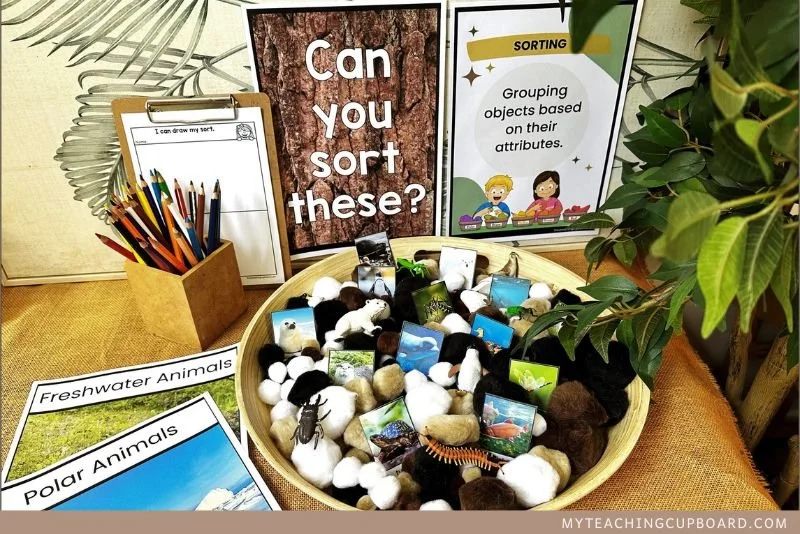6 Ways to Use Picture Sorts in the Classroom
Discover 6 innovative ways to use picture sorts in your preschool, kindergarten, or 1st-grade classroom! Learn how these versatile resources can enhance phonemic awareness, vocabulary, and more. Download ready-made picture sorts to save time and boost student engagement.
Do you spend hours planning hands-on educational activities for your classroom, only to find that they don’t quite align with your curriculum’s learning intentions?
If, like me, you’re passionate about play-based learning and want to make sure your students are meeting key educational benchmarks, this blog post will help you.
There’s a common struggle for many educators who believe in the power of play. The challenge lies in balancing engaging, play-based activities with the need to cover the many essential learning outcomes.
How can we ensure that our students are learning and practising important concepts through hands-on learning and play? With picture sorts!
Picture sorts are a versatile and effective tool for teaching various concepts, from phonemic awareness to science categorisation skills.
By introducing picture sorts during explicit teaching and small groups rotations, and then making them available at an investigation area, your students will be able to learn how to use them independently. This dual approach not only reinforces the skills taught during explicit teaching instruction but also encourages independent practice and revision.
In my experience, picture sorts
engage students
make complex concepts accessible and enjoyable
AND they are easy to integrate into both structured lessons and free play.
They really are a valuable addition to any classroom.
If you’re looking for ready-made picture sorts to save your time and enhance your teaching, check out the picture sort resources available in my store.
These sets are designed to be used over and over again, supporting different learning objectives and ensuring your students are always engaged and on task.
What Are Picture Sorts?
Picture sorts are hands-on educational activities that involve sorting picture cards into different categories based on various attributes like sounds, letters, themes, or concepts.
These activities can be used to teach important concepts during small group instruction and later revisited at an investigation area. I like this strategy because it promotes independent practice and skill reinforcement.
How Picture Sorts Work
Picture sorts typically consist of a set of picture cards or illustrated flash cards. Each set features images representing different categories like animals, objects, or actions. Along with the sorting cards, teachers often provide sorting mats or an anchor picture to define the sorting criteria.
The process of using picture sorts in the classroom is straightforward:
Introduction: Introduce the picture sort activity during a small group instruction. Explain the sorting criteria and demonstrate how to sort the cards.
Guided Practice: Allow students to practise sorting the picture cards with teacher guidance. This will help students understand the sorting criteria and how to apply them.
Independent Practice: Place the picture sorts in an investigation area. Students can then practise sorting independently, reinforcing the skills they learned during the guided session.
Example of a Picture Sort Activity
Imagine you are teaching your students about phonemic awareness, specifically focusing on initial sounds.
You prepare a set of picture cards with images like a cat, cup, fish, and fire. You also have anchor picture cards or sorting mats representing the sounds /c/ and /f/.
Introduction: During your small group instruction, you explain that today’s activity is about sorting pictures based on their initial sounds. You show the picture cards and the sorting mats with the letters Cc and Ff.
Guided Practice: You pick up the picture of the cat and ask the students what sound it starts with. Hopefully they respond with /c/ . You then place the cat picture card on the sorting mat representing the /c/ sound. Repeat this with the other picture cards, guiding students to place the fish and the fire pictures on the /f/ mat and the remaining picture of a cup on the /c/ mat.
Independent Practice: After practising together, you can move the picture cards and sorting mats to an investigation area. Here, students can practise sorting the cards independently, reinforcing their understanding of initial sounds.
The Benefits and Versatility of a Picture Sort
Picture sorts are not only fun but also highly educational. They can be adapted to cover a wide range of learning objectives, from phonemic awareness and phonics skills to categorising science concepts and building vocabulary. This makes picture sorts a versatile resource to have in any early years classroom.
When you use picture sorts in both your structured lessons and independent investigation areas, your students will be able to easily transfer and apply their sorting skills across different contexts.
In my classroom, picture sorts have been a game-changer. The kids love them, and they easily transfer the skills needed to practise picture sorting independently. This not only reinforces their learning but also encourages a sense of autonomy and confidence in their own abilities.
What are the benefits of picture sorts?
Picture sorts are an incredibly engaging way to teach students. The hands-on approach captures their interest and makes learning interactive and enjoyable.
For preschool, kindergarten, and 1st grade students, the tactile experience of handling picture cards adds a sensory dimension to learning, enhancing retention and understanding. We all know how important and effective hands-on learning or multi-sensory learning experiences are for our little ones so this method aligns well.
Versatility of Picture Sorts Across Subjects
One of the greatest strengths of picture sorts is their versatility. They can be adapted to fit a wide range of subjects and learning objectives.
Here are just a few examples:
Phonemic Awareness: Picture sorts help students identify and sort pictures based on initial, medial, or final sounds. This activity reinforces phonemic awareness, an important Science of Reading skill for early reading development.
Vocabulary Development: By sorting picture cards into categories, students can expand their vocabulary and improve their oral language skills. This is particularly useful in language-rich subjects like literacy and social studies.
Math Skills: Sorting is a foundational math skill. Picture sorts can be used to teach students how to categorise and classify objects based on attributes like shape, size, and colour. This type of activity also helps develop counting skills and number sense.
Science Concepts: Picture sorts can be used to teach and reinforce science concepts such as animal classifications, plant life cycles, and weather patterns. Students can better understand and remember these important concepts by categorising science-related images.
Development of Specific Skills
Picture sorts support the development of several key skills that are essential for young learners:
Phonemic Awareness: Sorting pictures based on sounds helps students become more aware of the phonemic structure of words, which is crucial for reading and spelling.
Vocabulary Development: As students sort and discuss picture cards, they are exposed to new words and concepts, enriching their vocabulary and language skills.
Sorting and Categorising: These activities help students develop the ability to classify and organise information, a fundamental cognitive skill that is useful in many areas of learning.
Counting and Number Sense: Sorting activities that involve counting objects or sorting by quantity help students strengthen their number sense and counting abilities.
Memory and Recall: Picture sorts can also improve memory and recall by encouraging students to remember and apply sorting criteria.
Building Important Life Skills
Beyond academic benefits, picture sorts also help students develop important life skills. The ability to sort and categorise information is a critical thinking skill applicable in many real-life situations. Additionally, picture sorts foster independence and self-regulation as students learn to complete tasks on their own during investigation time.
In my classroom, picture sorts have proven to be a valuable tool for engaging students and promoting independent practice. By implementing these versatile activities into both structured lessons and investigation areas, I have seen my students easily transfer and apply their sorting skills across different contexts. This not only reinforces their learning but also encourages a sense of autonomy and confidence in their abilities.
If you're looking for some versatile picture sorts to teach essential curriculum skills, check out the comprehensive selection of picture sorting resources available in my store. I use these sets over and over again as they support so many different learning objectives and ensure my students are always engaged and on task.
6 Ways to Use Picture Sorts in the Classroom
Picture sorts are incredibly versatile and can be used across various subject areas to enhance learning. Whether you’re teaching English language arts, general science, or social studies, picture sorts can be seamlessly integrated into your lesson plans.
Here are six effective ways to use picture sorts in your classroom to engage students and reinforce important concepts.
1.Teaching Phonemic Awareness Skills with Picture Sorts
Picture sorts are a fantastic tool for teaching phonemic awareness. By sorting pictures based on sounds, students can focus on beginning sounds, initial sounds, short vowels, or long vowels. I have found picture sorts can teach most phonemic awareness skills.
They help children develop the ability to hear, identify, and manipulate individual sounds in words, which is essential for reading readiness. Working with pictures also ensures you are working with sounds and not written alphabet letters. Phonemic awareness is an oral activity. Phonics involves the written representation of sounds.
Example: In my classroom, I often use picture sound cards for a sound sort activity. For example, we might focus on initial sounds by using picture cards with images like a mosquito, mushroom, nose and noodles.
During small group instruction, I introduce the sorting mats and explain that we will sort the pictures based on their beginning sounds. As we sort, I guide the students to place the mosquito and mushroom pictures on the /m/ mat and the noodles and nose pictures on the /n/ mat.
This hands-on activity not only engages the students but also reinforces their understanding of initial sounds in a fun and interactive way.
2. Learning Phonics Skills with Picture Sorts
Picture sorts also play a crucial role in teaching phonics by helping students connect speech sounds with alphabet letter sounds. They are an excellent way to reinforce letter names and their corresponding sounds, and in the end, make it easier for students to decode words.
Example: One specific phonics activity I use involves beginning sounds picture sorts. This set includes picture cards and sorting mats labelled with alphabet letters. I provide students with a mix of pictures and ask them to sort them based on the beginning sounds of each image, such as /k/ for kite and /p/ for popcorn.
This sounds picture sort not only helps students recognise speech sounds but also builds their confidence in associating these sounds with letters, another essential reading skill.
3. Learning How to Sort – A Math Skill
Sorting is a foundational math skill that helps students understand how to classify and organise objects based on different attributes. Picture sorts can be used to teach students how to sort by shape, size, colour, quantity and other characteristics.
Example: In a math based sorting activity, I can give students a set of picture cards depicting various shapes and sizes. We discuss the different attributes and then sort the pictures into groups based on their characteristics. Students might sort the pictures into circles, squares, and triangles, or group items by size (small, medium, large).
This activity not only teaches sorting but also enhances their understanding of categorisation and organisation, which are also critical math skills.
4. Categorising Science Concepts
Picture sorts can be an effective way to teach and reinforce science concepts. By categorising images, students can better understand and remember key ideas such as animal and plant classifications, weather patterns, properties of materials and more.
Example: During a science lesson on animals and their habitats, I give students picture cards of different animals. We then use my habitat sorting mats to categorise the animals into their different habitats.
Each picture has the name of the animal, and students sort them based on where they live. This activity helps my students grasp the concept of classification and reinforces their learning through hands-on practice.
5. Picture Vocabulary Cards for Building Oral Language
Picture sorts are excellent for building vocabulary and enhancing oral language skills. By sorting picture cards, students are exposed to new words and concepts, which can improve their speaking and listening abilities.
Example: One of my favourite vocabulary-building activities is to use picture cards to introduce new words. For example, we might focus on a theme like food. Students sort pictures of fruits and vegetables. As they sort, we discuss each picture and its name, encouraging students to use the new vocabulary in sentences.
This not only expands their vocabulary but also improves their ability to communicate effectively.
6. Picture Sorts Make Great Writing Prompts
Using picture cards as writing prompts is another one of my favourite ways to use these resources. The pictures on the sorting cards inspire students to create new and interesting stories. I like using labelled pictures because they help my students spell new words correctly. I’m all for phonetic spelling, but I’ve found my students love using the labelled pictures to get their stories started – they help to build their confidence.
Example: I often use picture sorts as a starting point for creative writing activities. For example, I might give students a set of picture cards depicting different animals. After sorting the pictures into categories such as their features or habitats, the students choose one to write a story or factual report about.
This activity is great for sparking their imagination but also provides a structured way for them to practise storytelling and report writing.
Use these six strategies to make the most of picture sorts in your classroom. They are a powerful tool for engaging students, reinforcing learning, and promoting independent practice.
If you're looking for ready-made picture sorts to save yourself time searching through countless images to find just the right picture, check out all the picture sorting resources available in my store. They include labelled pictures, sorting mats, writing paper, assessment checklists and more!
Picture Sorts for Independent Work
Independent work is a critical component of early childhood education. It
fosters self-reliance
boosts confidence
encourages students to take ownership of their learning
and lets you get some one-on-one testing done (insert wink emoji).
Picture sorts are a wonderful resource for promoting independent practice. They provide a structured yet flexible activity that students can complete on their own, making them ideal for use during investigation time, morning work, or even homework assignments.
Picture sorts can be easily integrated into your classroom routine to support independent practice.
For example, you might set up a literacy centre where students can access the picture sorts that focus on initial sounds. After a whole-class lesson on beginning sounds, students can visit the literacy centre and use the picture cards and sorting mats to reinforce what they've learned. This allows them to practise independently while you work with other students or groups.
I had a student in my class who initially struggled with phonemic awareness. During our small group sessions, we worked on sorting pictures based on their initial sounds. After a few sessions, I set up an investigation area with the same picture sorts for independent practice.
One morning, I noticed this student confidently sorting the picture cards on his own. He used the sorting mats to correctly categorise each picture according to its initial sound. The look of pride on his face was priceless! This activity not only reinforced his learning but also gave him the confidence to tackle other independent tasks with enthusiasm.
Using picture sorts in your classroom is a powerful way to promote independent practice. They provide students with the opportunity to apply what they've learned in a self-directed manner and help them understand and retain key concepts.
Whether used during whole-class teaching, as morning work, or even for homework, picture sorts are a versatile and valuable resource for any early childhood classroom.
Integrating Picture Sorts Into Group Rotations
It’s so easy to integrate picture sorts into your group rotation activities. During small group instruction, picture sorts can be used as both teacher-directed activities and independent work stations. This flexibility makes them a great tool for differentiated instruction and skill reinforcement.
In small group lessons, picture sorts allow for targeted instruction and personalised feedback. They enable you to address the specific needs of each student, ensuring that everyone is engaged and learning at their own pace.
Once students are trained in the process, picture sorts can also be used as independent activities, allowing students to practice and apply what they've learned without direct supervision.
If you have small group rotations like I do, you will probably have your class divided into small math and literacy groups. At one station, you can set up a teacher-directed activity using picture sorts to focus on initial sounds.
In this small group teacher-led lesson, you can introduce a set of picture cards and matching sorting mats. The group works together to sort the pictures based on the specific skill you are teaching, such as initial sounds, number of phonemes in a word, or 2D shapes. In a teacher-directed lesson like this, you will guide your students through the process and be able to provide immediate feedback and support.
At another station, you could have students who have already been trained in using picture sorts so they can work independently. You could give each student their own pack of picture cards and sorting mats, or you could pair students with a friend to work on the sorting activity together.
The kids would be sorting the cards on their own, reinforcing the skills they learned in the teacher-directed activity.
This independent work gives you the chance to focus on other groups while still ensuring that all students remain engaged and on task. You'll be able to eliminate busy work for your independent groups.
Here's an Example: You might have one group working on a phonics picture sort, where they sort pictures based on beginning sounds like /b/, /m/, and /t/. At the teacher-directed station, you introduce the activity and work through a few examples with the students, discussing the sounds and guiding their sorting.
Meanwhile, another group uses their individual pack of picture cards to complete their own sort independently, practising the same skills without direct teacher intervention.
Integrating picture sorts into group rotations offers a flexible and effective way to enhance your small group instruction. They provide the perfect balance of teacher-directed learning and independent practice.
They really are a valuable addition to your teaching toolkit! I just wouldn’t be without them. They help me deliver targeted instruction and keep my students engaged.
I spent hours sourcing suitable pictures and carefully compiling and creating my picture sorts and I’m happy to offer them to you. Check out all my picture sorts waiting for you to download.
Setting up Easy Investigation Areas or Literacy Centers
Setting up an investigation area or literacy centre with picture sorts is a straightforward way to create an engaging and educational space for your students. This learning area can be used for independent work, small group activities, or even as an extension of your whole class lessons.
Here’s how to set up and maintain an effective investigation area or literacy centre using picture sorts.
Choose a Location: Select a quiet and accessible corner of your classroom for the investigation area or literacy centre. Ensure there is enough space for students to spread out and work comfortably.
Gather Materials: Think about your current learning objectives, such as phonemic awareness, vocabulary building, or categorising science concepts (picture sorts are not confined to literacy) and choose a picture sort to meet your learning intentions.
Print out and cut up your picture cards and sorting mats. For added engagement, I like to add little toy representations of some of the pictures as well.
Include a couple of relevant texts and some paper and pencils so students can record their sorts. Sometimes I add a little camera so the kids can take a photo of their sort. Add any other resources you think your students would benefit from.
Organise Supplies: Use bins, baskets, or trays to organise the picture cards and sorting mats.
Create Instructions: Display clear and simple instructions and learning prompts for using the picture sorts. You might like to include visual aids and examples to help students understand the activities.
Provide Extra Challenges: Include options for an extra challenge to keep your advanced students engaged. Maybe this could involve more complex sorting criteria or additional steps, such as writing sentences using the sorted pictures.
Maintaining the Area and Keeping Students Engaged
Regularly Rotate Materials: To keep the area fresh and exciting, rotate the picture sorts and other materials regularly. This ensures students are exposed to new challenges and concepts.
Set Clear Expectations: Establish and communicate expectations for behaviour and usage of the investigation area. Make sure students understand the importance of treating materials with care and cleaning up after themselves.
Monitor and Support: Periodically check in on the area to ensure students are using it correctly and to provide support when needed. Encourage students to take ownership of the space and help each other.
Setup Tips
During a whole-class lesson,
I introduce the picture sorts and demonstrate how to use the sorting mats.
After the lesson,
I move the materials to the learning centre.
Students are then invited to visit the centre during independent work time, during investigation time and as an early finisher activity.
Setting up an investigation area or literacy centre with picture sorts is an effective way to create a dynamic learning environment in your classroom.
By following these practical steps and maintaining the area thoughtfully, you can keep your students engaged and ensure they have plenty of opportunities to reinforce their learning independently.
Conclusion
In this blog post, we’ve explored six different ways you can use picture sorts and how they can be integrated into various aspects of your classroom.
These hands-on educational tools can be used to teach essential concepts across so many different subject areas - from phonemic awareness and phonics skills to categorising science concepts and enhancing vocabulary.
We’ve discussed the numerous benefits of picture sorts, including their ability to engage students, support independent practice, and reinforce important skills through small group instruction and investigation areas.
You can create a more dynamic and interactive learning environment by incorporating picture sorts into your teaching strategies.
Whether used in group rotations, as writing prompts, or in a dedicated literacy centre, picture sorts provide a flexible and effective way to meet your educational goals while keeping students motivated and excited about learning.
So are you ready to transform your classroom with the power of picture sorts?
Download my ready-made picture sorts and save your valuable time in lesson planning and resource creation. You’ll be using them repeatedly and supporting so may different learning objectives.
With my picture sorts, you’ll be able to create purposeful and engaging activities that support your curriculum learning intentions!


